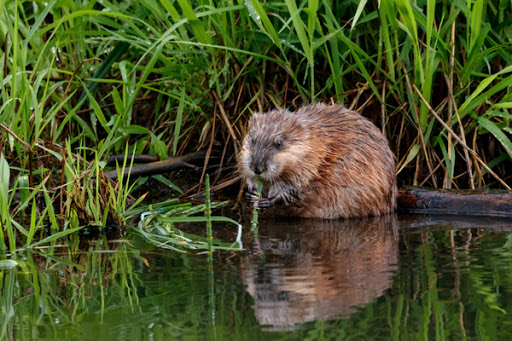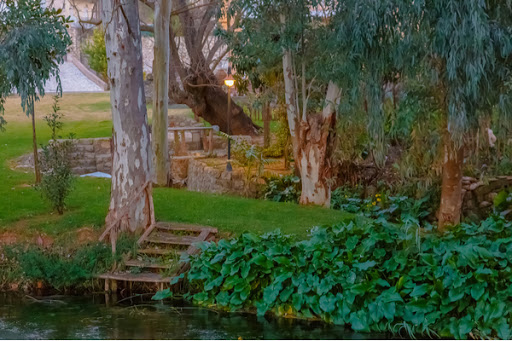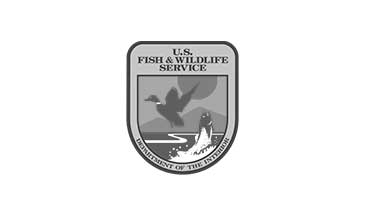Muskrats are large rodents that live and build burrows around bodies of water. They build their nests on riverbanks and streams where they can access large quantities of water-based plantlife. Muskrats can live anywhere with plenty of water-based vegetation they can eat and use to build their homes.
Muskrats aren’t dangerous or destructive, but they can be a nuisance nonetheless. Muskrat families need a lot of food. If they can’t get that food near the water, they may start looking for it near your home. When muskrats burrow, they can hurt lawns, gardens, and even structures. Luckily, because muskrat dens have very specific needs, there are also specific ways to prevent them. Here’s what you should know about the waterborne rodent, and how to keep it away from your home.
What are muskrats?
Muskrats (Ondatra zibethicus) are the largest rodents in the Arvicolinae or “microtinae” family. Adults grow to about 20” long, weigh two to five pounds, and appear stocky or round. Adults have laterally flattened, nearly hairless tails that are around nine inches long. Muskrat fur is brown or tan, with darker brown or reddish-brown or black undertones. The rodents have distinctively large, partially webbed hind feet for swimming and smaller front feet for digging.
You’re probably familiar with muskrats as unusual swimming rodents. They live in and around water in swamps, wetlands, lakes, ponds, streams, and marshes. The mammals frequently dig underwater tunnels called “runs” that lead into hidden, subterranean burrows on the sides of riverbanks. They may also use mud and vegetation to build conical, domed nests with multiple “run” entrances and exits. Muskrats are very social and typically live in large families with discrete territories. The name “muskrat” refers to the musk these mammals secrete from their tails to mark their territories.

What do muskrats want?
Muskrats need to live near water and food. Muskrats are primarily herbivores, and feed on waterborne vegetation such as cattails, bulrushes, water lilies, or pickerel weeds. In the absence of abundant food sources, the mammals will also eat crayfish, frogs, turtles, grasses, or shrubs. They also prefer to live in areas with overgrown vegetation so they can use it to build their burrows. They typically build these burrows on the banks of water sources near food and natural shelter.
Muskrats are big eaters. An adult muskrat will eat one-third of its own body weight every day. They also have to provide food for their offspring. Babies are called “kits.” Kits stay with their family in the nest for six weeks after birth. Most muskrat adults stay within 150 feet of their territory, though they’ll venture further away for food if they must. Muskrats also need to keep cool, which means they prefer shady, sheltered water sources out of direct sunlight.
Why are muskrats near me?
Unfortunately, if you see muskrats near you, it’s probably because they live near you. Specifically with 150 feet of you, usually! If muskrats really do live near you, then they live in whatever water feature is closest to you. They’re using that water feature as a source of food, shelter, shade, and building materials for their nests. You might notice burrowing holes or digging damage near the banks of the water or even into your yard.
Muskrats choose their home territories based on access to food. The den living near you must be satisfied with nearby food options. Muskrats eat a lot, so it’ll probably be pretty easy to see what they’re eating. Look for damaged river vegetation, uprooted grass, or even chewed-up shrubbery. A muskrat will only establish its den where they feel cool and comfortable. They likely built their burrow in a shaded, relatively secluded or sheltered area. They may even use your dock or shed as a source of cover!

How can I keep muskrats away?
First and foremost, you’ll want to eliminate muskrat food sources. If muskrats can’t get their food near you, they’ll have to move to get it elsewhere. Remove any waterborne vegetation growing around the banks of water features near your home. Trim down shrubs, cut away tiger lily, and remove ornamental grasses near the water. Keep the banks of the water near your home as clear and clean as you can. Treat waterborne plant life like weeds and remove them regularly.
Make the area around the muskrat’s burrow as unappealing as possible. Exclude muskrats from structures they could use as shelter. Patch up holes or gaps beneath shed foundations. Keep any docks or other structures that contact water clear of weeds or other vegetative buildup. After clearing the area around the water, make other potential food sources in your yard inaccessible, too. Fence off your garden, trim down your shrubs and ornamentals and clean up fallen fruits.
Even if you find it, we recommend against removing a muskrat’s burrow yourself, which will be ineffective and dangerous. Instead, stick to the exclusion methods we’ve outlined above. If you can make your yard unappealing to muskrats, they’ll probably leave on their own.
If muskrats won’t leave on their own, get in touch with Varment Guard right away. Our experts can remove muskrats from your water and lawn quickly, safely, humanely, and permanently. If you’re tired of watching muskrats chomp away at your banks, give us a call today.






